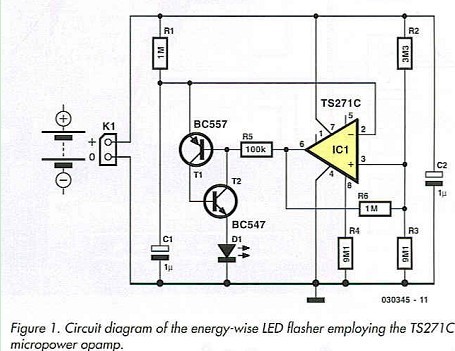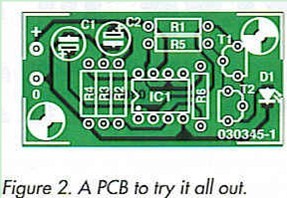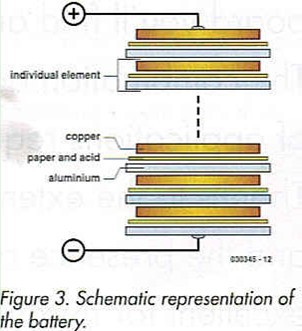

Project Solutions
Kitchen Table
Published:2011/7/26 22:03:00 Author:Phyllis From:SeekIC
By Prof. Dr. Martin Ohsmann
Low-Power LED Flash powered by lemon juice
This circuit will need just a few micro-amps to make an LED flash. The energy comes from a home made ’vegetarian’ battery.
We have to admit that the circuit shown in Figure 1 appears a bit over the top for an on/off indicator, as the same functionality could have been achieved from a classic combination of an LED and a series resistor. However, the circuit is unbeaten we feel in that it shows how a visual on/off indication may be realized in battery-powered equipment, while using a minimum of energy. 
It is of course impossible to make an LED light continuously with very little current. The solution is to make it flash briefly. The requirement, then, is for a low-energy oscillator capable of creating an extremely low duty factor (on/off ratio). A large time constant is realized by capacitor CI in conjunction with charging resistor Rl. Micropower opamp IC1 acts as an inverting comparator, monitoring the voltage on CI and comparing it with a threshold level defined by resistors R2 and R3. Once capacitor CI contains sufficient charge, it has to be discharged again. The energy stored in the capacitor is of course not wasted but put to good use — in this case powering the LED.
In order to create a relatively intense current peak through the LED, the capacitor is discharged through a ’thyristor tetrode’ formed by Tl and T2. This composite device is triggered by the comparator via R5. Because the thyristor tetrode does not consume current as CI is being charged and the Micropower opamp itself is an extremely energy-wise component, the total current consumption remains extremely low — just 15 uA at 12 V. The circuit will function from a supply voltage as low as 3.5 V, although the LED in that case will not light brightly anymore. On a positive note, the current consumption is then reduced to just 4 uA!
Construction
The construction on the printed circuit board shown in Figure 2 is not critical in any respect. Capacitor CI must be a foil-dielectric type (for example, Siemens MKT). C2, too, should exhibit a low leakage current because otherwise the current consumption will be far higher than desired. The LED should be a ’high-intensity’ or a ’low-power’ type. 
The introductory photograph shows an initial attempt at construction using Vero board.
The circuit employs a micropower operational amplifier type TS271C from ST (formerly SGS-Thomson). This is not a direct replacement form the TLC271, although the latter device may also be used in this circuit if you remember to link pin 7 to 8 in order to preserve the low-bias setting. Resistor R4 which defines the bias current with the TS271 is then omitted.
Add some lemon juice
The extremely low current consumption at reasonable supply voltages actually allows our little circuit to be powered from a home-made battery. The general idea is depicted in Figure 3. 
The battery consists of a nine individual elements connected in series by stacking. Each element is made up from a (coppered) coin with a diameter of 10-15 mm, a separating sheet made from kitchen paper soaked in lemon juice, and a piece of aluminium foil. The components that constitute the ’veggie battery’ are also visible in the introductory photograph.
Several experiments were carried out and the following procedure was found to give best results: fold the aluminium foil eight times and use the circumference of the coin to cut out eight round packets in one go. Next, cut nine square pieces of kitchen paper, the edges should be slightly longer than the diameter of the coin. This is necessary to prevent a short circuit between copper and alurninium. Then saturate the paper with lemon juice. Freshly pressed juice will work better than juice from a bottle!
The lower part of the battery assembly is formed by a slightly larger piece of aluminium foil — this will act as the negative terminal. On it lies a paper disc. Then stack on a coin, an aluminium disc, a paper disc and so on, right up to the top coin that acts as the positive terminal. If you are satisfied with your creation, the presence of a voltage may be proved with the aid of a high-impedance digital voltmeter. The battery terminal voltage should be between 3 V and 4 V. Connect the battery to the circuit and you’ll be able to watch the LED flash for quite a while getting its energy from... lemon juice!
Reprinted Url Of This Article: http://www.seekic.com/blog/project_solutions/2011/07/26/Kitchen_Table.html
Print this Page | Comments | Reading(1819)
Article Categories
New published articles
· Imagination works with TSMC to develop FinFET process
Author:Ecco Reading(32821)
· XMOS pushes event-driven MCUs with lower price
Author:Ecco Reading(3526)
· Intel brings upgraded 32-nm SoC for smartphones
Author:Ecco Reading(3246)
· Micron pushes TLC 128-Gbit NAND flash
Author:Ecco Reading(3801)
· Intel will stop supplying desktop motherboards
Author:Ecco Reading(5331)
· Processor market was expected to regain strength in 2013
Author:Ecco Reading(3315)
· It was reported that TSMC sales fall steeply
Author:Ecco Reading(3462)
· Cisco, NXP work with auto wireless startup
Author:Ecco Reading(3604)
· Micron was impacted by manufacturing glitch
Author:Ecco Reading(4009)
· China can make 22-nm transistor by themselves
Author:Ecco Reading(3807)
· Chip market rebound is coming, according to survey
Author:Ecco Reading(3748)
· Sony, Toshiba will spend more on chips, iSuppli reports
Author:Ecco Reading(3780)
· Qualcomm becomes the 13th company to join NFC Forum board
Author:Ecco Reading(6094)
· TSMC increases building work for FinFET fab
Author:Ecco Reading(3764)
· TI plans to cut 1,700 jobs in OMAP shift
Author:Ecco Reading(4579)